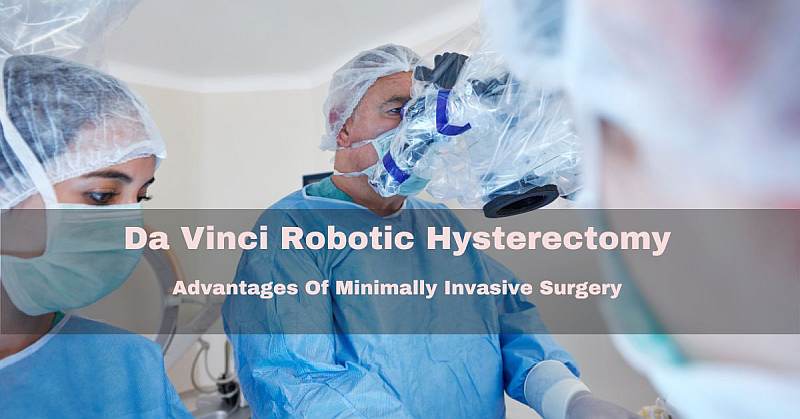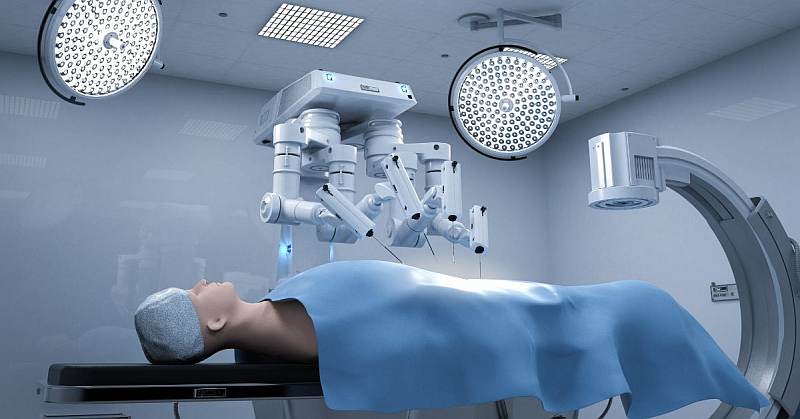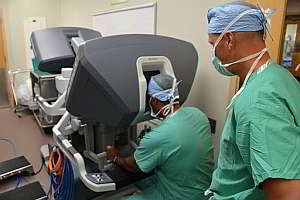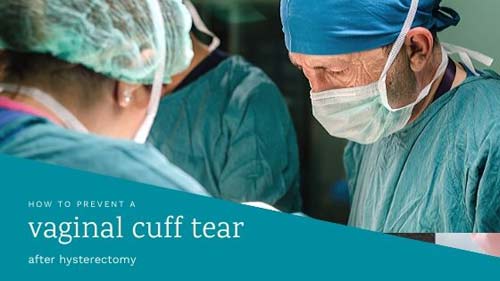Embracing Robot-Assisted Precision: Da Vinci Robotic Hysterectomy for a Smoother Recovery
Welcome to our comprehensive guide on Da Vinci robotic hysterectomy, a cutting-edge, minimally invasive surgical procedure that utilizes robotic-assisted technology for optimal outcomes. If you’re in search of a surgical option with shorter recovery times, less pain, and reduced scarring, then DaVinci hysterectomy may be the solution you’ve been looking for.
In this post, we will explore this advanced procedure and its benefits in detail and compare it to other types of hysterectomy surgeries. By the end, you will thoroughly understand DaVinci hysterectomy and be empowered to choose your treatment wisely.
This blog is reader-supported. When you buy through a link on our site, we earn a commission at no extra cost to you. Read more

Understanding Hysterectomy: The Basics and Benefits
The term hysterectomy refers to the surgical procedure of removing the uterus and is used to treat various conditions such as fibroids, endometriosis, cancer, and abnormal uterine bleeding. It is important to understand this procedure and its benefits clearly to make an informed decision about your treatment options.
Advantages of Minimally Invasive Hysterectomy
Minimally invasive hysterectomy approaches, like the DaVinci hysterectomy, offer several advantages over traditional open surgery:
- Shorter hospital stays: Minimally invasive procedures usually require less time in the hospital, allowing you to return to your normal activities faster.
- Reduced postoperative pain: Minimally invasive techniques often result in less pain than open surgery, making the recovery process more comfortable.
- Decreased blood loss: These procedures typically involve less blood loss during surgery, minimizing the need for transfusions.
- Faster recovery times: These techniques can lead to quicker recovery times, enabling you to resume your daily routine sooner.
These advantages make minimally invasive hysterectomy a preferred option for many patients.
What is a da Vinci robotic hysterectomy?

The da Vinci Surgical System is crucial in Da Vinci’s hysterectomy procedures. It consists of robotic arms that replicate the movements of a surgeon’s hands, wrists, and fingers, offering enhanced precision and control during surgery.
The Surgeon’s Interface: Operating the Robotic System
Surgeons operate the da Vinci Surgical System through a console, communicating between the surgeon and the robotic arms. From the console, the surgeon controls the precise movements of the robotic arms using hand and foot controls.
A robotic-assisted hysterectomy uses a laparoscope, a straight tube with a tiny camera on the end of it, and the means to blow gas into the abdominal and pelvic space to elevate the abdominal wall to see the structures better.
By making small incisions in the abdomen and pelvic area, a laparoscope can enter, as well as other tools like electrocautery, suturing tools, trocars, and scissors, to do the surgery.
The surgeon does not actually see the uterus and surrounding tissues during robotic surgery. Instead, images of these structures are visible on a screen that is suspended over the surgery. Using a computer that uses robotic technology, the surgeon makes precise cuts inside your pelvis so they can remove the uterus from the body.
Comparing DaVinci Hysterectomy with Traditional Laparoscopic Surgery

DaVinci hysterectomy and traditional laparoscopic surgery are both minimally invasive approaches for hysterectomy procedures. They offer several advantages over open surgery, including smaller incisions and quicker recovery times.
However, DaVinci hysterectomy, which utilizes robotic technology, provides additional benefits that set it apart from traditional laparoscopic surgery.
Here’s a closer look at the key differences:
- Precision: DaVinci hysterectomy offers increased precision due to the robotic-assisted technology. It allows surgeons to control the robotic arms more precisely, allowing for more exact movements during the procedure.
- Visualization: With the da Vinci Surgical System, the surgeon benefits from better visualization. The system provides a highly magnified, 3D view of the surgical area, enhancing the surgeon’s ability to see and navigate delicate structures.
- Dexterity: The robotic arms used in DaVinci hysterectomy offer improved dexterity, replicating the movements of the surgeon’s hands, wrists, and fingers. This enhanced dexterity allows for more precise suturing and dissection, resulting in a better surgical result.
While traditional laparoscopic surgery is still a viable choice for many patients, DaVinci hysterectomy may provide additional advantages that align with your specific needs and preferences.
Who can have a robotic hysterectomy?
DaVinci hysterectomy is a suitable option for various medical conditions, including fibroids, endometriosis, uterine prolapse, and abnormal uterine bleeding. The advanced robotic-assisted technology used in DaVinci hysterectomy allows for precise and controlled surgical procedures, resulting in better patient outcomes.
Common Medical Conditions Treatable With DaVinci Hysterectomy
DaVinci hysterectomy is an effective treatment option for several medical conditions. Typically, they use it to address the following:
- Fibroids: A DaVinci hysterectomy can assist in the removal of uterine fibroids, which are noncancerous tumors that can cause pain, heavy bleeding, and other symptoms.
- Endometriosis: This condition involves uterine tissue that grows outside the uterus, resulting in pain, infertility, and other complications. DaVinci hysterectomy can remove the affected tissue.
- Uterine Prolapse: DaVinci hysterectomy can address uterine prolapse, when the uterus falls in the vaginal canal, causing discomfort and other symptoms.
- Abnormal Uterine Bleeding: A DaVinci hysterectomy can help treat abnormal uterine bleeding, which hormonal imbalances, polyps, fibroids, or other underlying conditions may cause.
The main advantages of da Vinci’s robotic hysterectomy
The main advantage of having a robotic hysterectomy is that it makes small incisions in the abdominal wall. Hence, your recovery time is much less than with an open abdominal hysterectomy. Your stay in the hospital will be much shorter, and you will get back to your normal routine faster than with open surgery. The risk of infection and bleeding complications is less than with an open hysterectomy.
Robotic-Assisted Surgery: Is it right for you?
Although DaVinci hysterectomy offers many benefits, not everyone is a good candidate for robotic surgery. Before this procedure, they consider factors such as the individual’s previous surgical history, overall health, and the extent of the condition.
Patients must consult a qualified hysterectomy surgeon to assess their suitability for DaVinci hysterectomy. A skilled surgeon will evaluate the patient’s medical history, perform a thorough examination, and discuss their individual needs and concerns.
The Importance of Consulting with a Qualified Hysterectomy Surgeon
Choosing a qualified hysterectomy surgeon is crucial for ensuring successful outcomes and a safe surgical experience. A qualified surgeon will have specialized training and expertise in robotic-assisted surgeries, including DaVinci hysterectomy.
When selecting a qualified surgeon, consider the following:
- Board Certification: Look for a surgeon who is board-certified in gynecology or gynecologic surgery, indicating their expertise.
- Experience: Inquire about the surgeon’s experience with DaVinci hysterectomy and their success rates. Surgery performed by an experienced surgeon is more likely to give the best results.
- Communication: Look for a surgeon who listens carefully and provides clear and understandable explanations of the procedure. Good communication promotes a strong doctor-patient relationship and fosters confidence in the surgical process.
- Check the facility-level accreditation: Confirm the facility will provide a safe and reliable environment for surgery.
By consulting with a qualified hysterectomy surgeon, you can trust that you are in capable hands and receive the highest level of care throughout your DaVinci hysterectomy journey.
The disadvantages of a robotic hysterectomy
There are risks to having robotic surgery. Some of these risks include those found in any surgery. Risks like bleeding, infection, damage to other pelvic and abdominal organs, and anesthesia complications. A Da Vinci robotic hysterectomy takes longer than other types of surgery, so the anesthesia risks are slightly greater.
Other issues you may want to consider:
- The robotic system has a complex user interface, making it harder for some surgeons to learn to use the device. To lower your risk of complications, take some time to investigate how much experience your surgeon has with the da Vinci robot.
- It is also possible that during the operation, the surgeon needs to convert to another technique and make a larger abdominal incision.
- Note that, with a Da Vinci robotic hysterectomy, there is not only the risk of human error but also a chance for mechanical failure of the equipment. Malfunctions of the robot’s arm, camera malfunctions, and computer software problems are highly uncommon but have been reported.
- In 10% of robotic surgeries, they use a power morcellator. They use this device to cut a uterus into smaller pieces if it is too big to remove through the vagina. Or if it cannot fit through the tiny incisions in the abdomen. But the device can also spread undiagnosed uterine cancer. This can happen when fragments of malignant tissue stay in the abdominal cavity and attach to other internal organs.
According to the FDA, 1 in 350 women who need a hysterectomy for fibroids suffer from undiagnosed uterine cancer without knowing it. Before robotic surgery, your physician has to explain the risks of using a power morcellator, and they may ask you to sign a morcellation consent form.
Preparation and Recovery: What to Expect?
Before undergoing a DaVinci hysterectomy, there are several essential steps you need to take to prepare for the procedure. These steps include:
- When it comes to your upcoming surgery, it’s important to make sure you feel comfortable and informed every step of the way. One way to do that is by scheduling a pre-operative consultation with your surgeon. This is a chance for you to discuss the surgery, ask any questions, and address any concerns you might be feeling.
- Medical evaluations to make sure you’re healthy and can handle the procedure.
- To follow any lifestyle adjustments your surgeon recommends, such as quitting smoking or adjusting medications.
The da Vinci robotic hysterectomy procedure itself
You will receive an IV for anesthesia and fluids when undergoing a robotic hysterectomy. You will also have a bladder catheter to drain urine to keep the bladder out of the way during surgery. While under general anesthesia, an endotracheal tube will be inserted into your throat to assist with breathing during the surgery.
The surgery itself will take about 3-4 hours, during which you will be asleep. The surgeon will start by making 3-4 incisions, with one of the incisions being just beneath the belly button (umbilicus).
The laparoscope is inserted into the abdominal and pelvic space, and then they inflate gas into the abdomen to better highlight the organs. The robotic instruments go into some of the other incisions. The surgeon uses a remote control device to separate the uterus from its surrounding pelvic structures.
Once free, they can either remove the uterus through the vagina in one piece or cut it into several small pieces (morcellated). At the end of the surgery, they close the incisions with a couple of dissolvable stitches or staples.
They remove the bladder catheter once you are up and about and can use the restroom yourself. You may stay in the hospital for 1-2 days after surgery.
In some cases, they recommend compression stockings to prevent blood clots from developing in the deep veins of the calf. This is the danger of prolonged immobility.
Da Vinci hysterectomy recovery
Recovery time after a robotic hysterectomy can vary for each patient, but there are general guidelines that can help you understand what to anticipate:
- Following surgery, you will be taken to a recovery room before being transferred to another room in the hospital.
- Healthcare professionals will monitor your vital signs and pain levels to ensure a smooth recovery.
- You will have incisions requiring care and attention, including keeping them clean and dry.
- You will receive instructions from your surgeon regarding post-operative care, such as when and how to take prescribed medications and any restrictions on physical activities.
Robotic Hysterectomy Recovery Time and Postoperative Care
The recovery time after a robotic hysterectomy can vary from person to person. How you recover after surgery can vary depending on many things, like how you’re feeling overall, how complicated the procedure was, and how well you take care of yourself afterward. Typically, women can return to normal activities within 4 to 6 weeks from the procedure.
It’s super important to follow the postoperative care instructions given by your surgeon if you want a smooth and speedy recovery. This may include:
- Take your prescribed medications as directed. It’ll help you stay comfortable and prevent any infections.
- Engaging in light physical activity as recommended to promote healing and prevent blood clots.
- Support your body’s healing process by eating a balanced diet and staying hydrated.
- Keep in touch with your surgeon for follow-ups.
Recovery from Robotic Hysterectomy Week by Week
Recovery from a robotic hysterectomy typically progresses gradually over the weeks following the procedure. Here is a week-by-week breakdown of what you can expect:
Week 1: You may experience some discomfort and fatigue, and it is essential to rest and take pain medications as prescribed. Avoid strenuous activities and focus on gentle movement and light walking. For the first weeks, you should shower rather than have a bath in the tub. Soaking in water does not promote the healing of wounds (inside and outside) and increases the risk of infection.
Week 2: Your incisions should start to heal, and you may gradually increase your activity level under your surgeon’s guidance. However, still avoid heavy lifting and intense exercises before the wound at the top of the vagina has healed. Internal stitches can rip loose, and you’ll increase the risk of emergency surgery to re-stitch the vaginal cuff. You can usually drive within a week of minimally invasive surgery. Most women feel relatively well without needing pain medications after about two weeks.
Week 3: You should begin to feel more energy and experience less discomfort. You can slowly resume more regular activities while listening to your body and avoid overexertion. When can you get back to work? This depends mostly on how you feel. Some women can return to their job after 2 weeks. But others need 4 weeks before they feel ready to go back. If your work requires physical effort, you better wait a bit longer.
Week 4: Most women feel significantly better and can resume most of their normal activities at this point. However, it’s important to continue following your surgeon’s instructions regarding lifting restrictions and physical exertion.
Week 5: You should feel close to your pre-surgery self, but it’s crucial to gradually ease back into more intense activities.
Week 6: At this stage, you should fully recover and resume all of your regular activities. However, it’s still important to listen to your body and not push yourself too hard, as everyone heals at a different pace. Some women are under the impression that with minimally invasive surgery, they can resume having sexual intercourse sooner than with abdominal surgery. But, even with a da Vinci robotic hysterectomy, you must wait at least 6 weeks. It usually takes that long for the inner wound at the top of the vagina to heal.
By following the postoperative care instructions and understanding the progression of recovery week by week, you can optimize your healing process and ensure a successful Da Vinci hysterectomy recovery.
DaVinci Hysterectomy Success Stories
Hearing success stories from patients who have undergone DaVinci hysterectomy can provide valuable insights and reassurance to individuals considering the procedure. Real-life experiences and testimonials can help future patients understand the surgery’s advantages, how effective robotic surgery is, and its positive impact on patients’ lives. These stories can inspire and provide confidence during the decision-making process.
What are the long-term outcomes of robotic-assisted laparoscopic hysterectomy?
Long-term outcomes of robotic-assisted laparoscopic hysterectomy are typically positive. The procedure effectively removes the uterus while offering minimal scarring and reduced risk of complications. Most patients experience improved quality of life and resolve their underlying medical condition.
We encourage you to consult a qualified surgeon with additional concerns or questions about robotic-assisted laparoscopic hysterectomy. They can provide personalized answers based on your unique situation and address any specific concerns you may have. Remember, the more you know, the more confident you are to make the right decision for your health.
Conclusion
In conclusion, the DaVinci hysterectomy provides patients with a state-of-the-art, minimally invasive surgical option that offers numerous advantages over traditional approaches. Through the use of precise robotic technology, this procedure ensures greater precision and control, resulting in improved surgical outcomes. Because of shorter recovery times and less pain, it’s gaining popularity among those seeking a quicker recovery and enhanced quality of life.
Are you considering a Da Vinci robotic hysterectomy? Please feel free to share your experience in the comments below.
Source Links
- https://www.bcm.edu/healthcare/specialties/obstetrics-and-gynecology/ob-gyn-procedures/da-vinci-hysterectomy
- https://www.mayoclinic.org/tests-procedures/robotic-hysterectomy/about/pac-20384544
- https://my.clevelandclinic.org/health/treatments/21057-robotic-assisted-hysterectomy
Related posts
- How to prevent a vaginal cuff tear after hysterectomy
- The Undeniable Benefits of a Hysterectomy
- Hysterectomy Preparation Checklist
- Tips to Prevent Blood Clots after Hysterectomy That Can Save your Life
- Stressed About Hysterectomy Risks? What Every Woman Must Know








I had this procedure done in 2018 and waited 6 weeks before I had sex. Every time I have sex I experience spotting only during sex. I’ve had more biopsies done and no cancer but this issue is ongoing and depressing. Has anyone else experienced this?
Had my surgery done at Hartford Hospital by Dr. Heather Einstein. I have not recovered fully in the past three years. I had a vaginal cuff dehiscience, and have had bloating and pain ever since. I am also no longer to have sex with my husband.
I was supposed to have Davinci hysterectomy with uterus and large fibroid tumor growing inside removed vaginally. When I finally came to, about 12 hours later, (I believe I was given waaaay too much anathesia: a pill cocktail prior to surgery that included gabapentin, a type of spinal block, and intravenous ketamine during surgery) was told that they weren’t able to remove tumor vaginally, and that it was removed via my csection scar area. My tumor and uterus weighed in at 260 g, so not huge. After my blood pressure returned from the stratosphere, and my oxygen levels were high enough, I was discharged, 2 days after surgery. I had a total of 6 external incisions, 4 round ones used with DaVnci, and 2 elongated incisions , a vertical one above my belly button, about 2”, and a 4-5” horizontal over my old csection scar. I know I have internal sutures but not how many. Recovery has been wretched. Between raw sort of pain, and feeling soooo tired. I guess I should also mention that I am underweight, around 100 lbs st time of surgery. I had had the procedure scheduled further out , but after about a week of nausea/vomiting for unknown reasons, the hospital bumped up my surgery to about a month sooner than originally expected planned. One month after surgery, one of the “port” holes used for davinci is somewhat infected, and tender to the touch. I just began a course of antibiotics to treat infection and am waiting to hear back on cultures taken. If I had to do it over, I would have looked for a nonsurgical holistic approach.
I had my complete hysterectomy done on 5/23/19, with Dr. Davis at the Denver, CO OBGYN- Oncology office; the surgery was done at Swedish Hospital in Denver. Dr. Davis has done over 1,000 surgeries with the Da Vinci robot. I was recommended to him from another OB-GYN office, because 1) I have had many belly surgeries in the past, which meant that I had many old adhesions and scar tissue; 2) I am 61 and 3) I have diabetes (which slows down healing). The surgery went well; they got all the cancer by doing the hysterectomy and didn’t have to take the lymph nodes. The hospital was very nice and the nurses were supportive; I was up walking within hours and went home the next day. The only problem I had was that one incision became infected and had to be cleaned and treated three times daily with peroxide. I feel good four weeks later, and although I have to be a little careful with my belly muscles sitting, standing, and pulling up, I will be going back to work. They gave me a prescription for Demerol; I took one and didn’t take any more; Tylenol (NOT advil or Motrin; enhances bleeding) and Tylenol PM were all I needed. The worst part was the excruciating pain for 48 hours afterward – in my right shoulder! That’s where (they tell me) the air that they used to inflate your belly comes out. A heating pad helps! Also, I had a ‘Cough pillow” given to me by the PA; pressing that against my abdomen sure helped when I coughed or sneezed!
has anyone done a robotic assisted myomectomy to remove fibroids with a DaVinci in Adelaide? Where did you have your surgery done?
I’m 41 and had this done about 5 weeks ago. I had the uterus and fallopian tubes removed. I stayed in the hospital overnight. Biggest problem I had was back pain. My catheter also gave me issues. BUT all that went away eventually. I’m glad that I had this procedure. My cramping is gone from my endometriosis. I also had fibroids on my uterus. I recommend this procedure.
I am having this procedure done too tomorrow for the same reasons… fibroids and endometriosis. I’m also 41! How are you feeling now? Any endo pain?
I am 62 years old. I had post menopausal bleeding for about 2.5 months. I was diagnosed with endometrial cancer. I had a complete robotic hysterectomy on July 30 2018 and went home the same day. I had my post op appointment 2.5 weeks later and results from biopsies were good and returned to work the next day.
Where did you have your surgery done?
I’m having surgery next week and I’m very nervous. How are you ladies feeling?
I’m having surgery due to abnormal bleeding.
Is it worth it? Please comment on other organs, engagement with partner and hormones.
Thank you,
Tina
Had total hysterectomy with DaVinci 4-20-18 due to cervical cancer, was home next day, only needed Motrin for pain which was hardly any. The worse thing was and still is trying to pass a bowel movement(sorry if tmi), but I highly recommend the Squatty Potty, it really helps. Got results back with no active cancer cells.
Where did you have your surgery done?
I am 47 yrs old and had abnormal bleeding for 2.5 months. My doctor did an in office endometrial biopsy. She informed me that they diagnosed precancerous cells and I needed a hysterectomy and referred me to an Oncologist. Just had my Robotic hysterectomy yesterday early morning and was home by 3:00 PM same day. Today woke up bloated and crampy but I am getting around ok and am very happy that I was offered the robotic surgery. I won’t get results for about 5 days but I am keeping positive and would advise anyone needing a hysterectomy to ask if your a candidate for the robotic way. My Doctor and all her team were great.
How are you feeling? Next week I am having the same procedure. As the day of surgery gets closer, my anxiety increases. The results scare me more than the surgery.
Where did you have your surgery done?